SAP 103: An In-Depth Review of Australian Welfare Law on the Disabled
VerifiedAdded on 2022/11/13
|7
|1739
|62
Report
AI Summary
This report provides a comprehensive review of Australian welfare law, specifically focusing on the financial support available to disabled persons through the Disability Support Pension (DSP). The report examines the DSP policy, its administration by Centrelink, and its impact on a significant portion of the Australian population. It delves into the historical context, including the ratification of the Convention on the Rights of Persons with Disabilities and the definition of disability used in Australia. The discussion section analyzes the criticisms and reforms the DSP has undergone, including mutual obligation requirements and efforts to reduce the number of recipients. The report also examines the perspectives of various scholars, such as Humpage, Brown, McVicar, Wilkins, McCallister, and Soldatic & Fitts, who have researched the policy's effectiveness, the challenges faced by indigenous Australians, and the assessment processes involved. The review concludes by highlighting the challenges faced by the DSP, including the increasing number of recipients, the tax burden on the government, and the difficulties faced by indigenous Australians in accessing support. The report underscores the need for further reforms to ensure inclusivity and participation of disabled persons while providing necessary financial support.
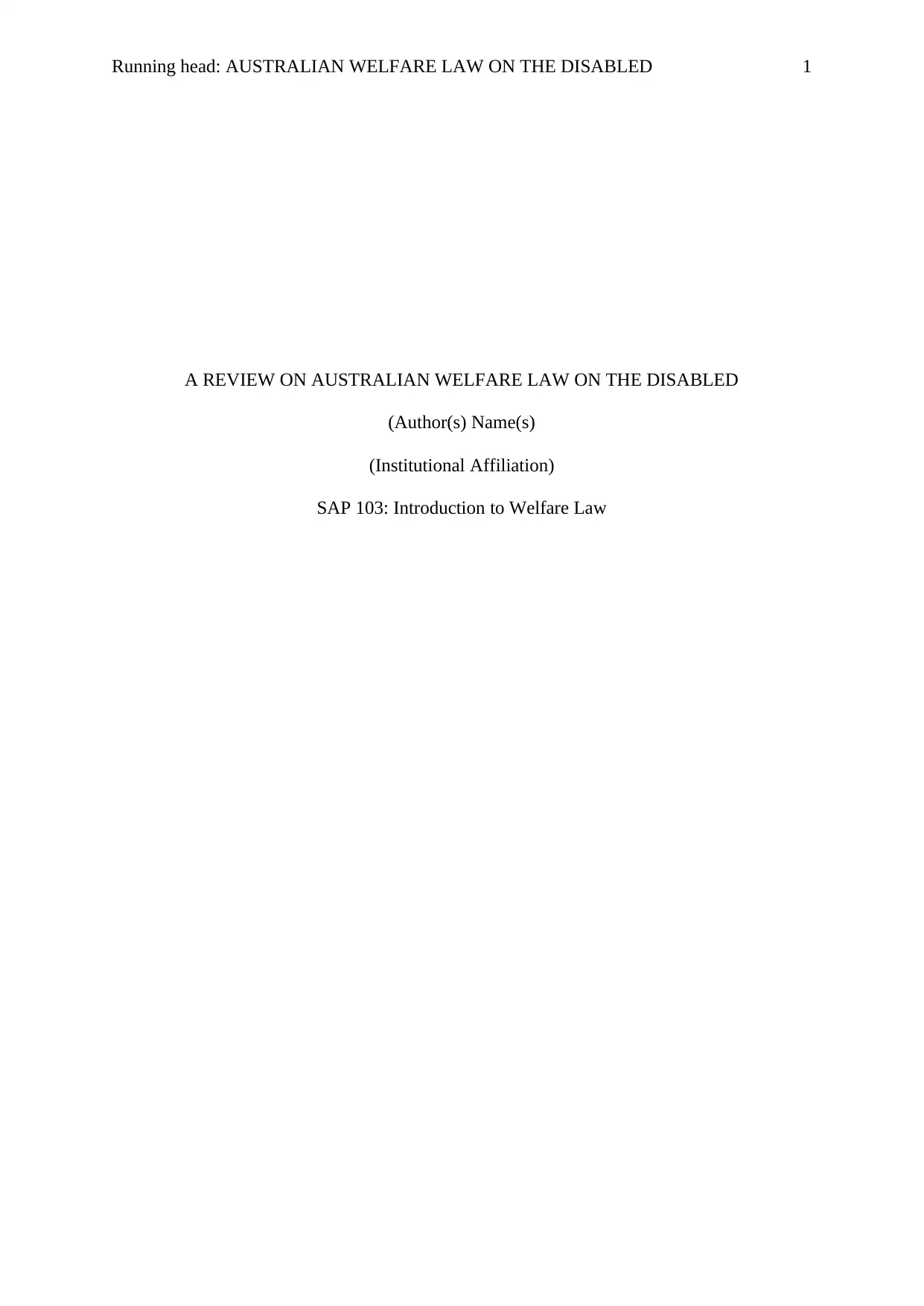
Running head: AUSTRALIAN WELFARE LAW ON THE DISABLED 1
A REVIEW ON AUSTRALIAN WELFARE LAW ON THE DISABLED
(Author(s) Name(s)
(Institutional Affiliation)
SAP 103: Introduction to Welfare Law
A REVIEW ON AUSTRALIAN WELFARE LAW ON THE DISABLED
(Author(s) Name(s)
(Institutional Affiliation)
SAP 103: Introduction to Welfare Law
Paraphrase This Document
Need a fresh take? Get an instant paraphrase of this document with our AI Paraphraser
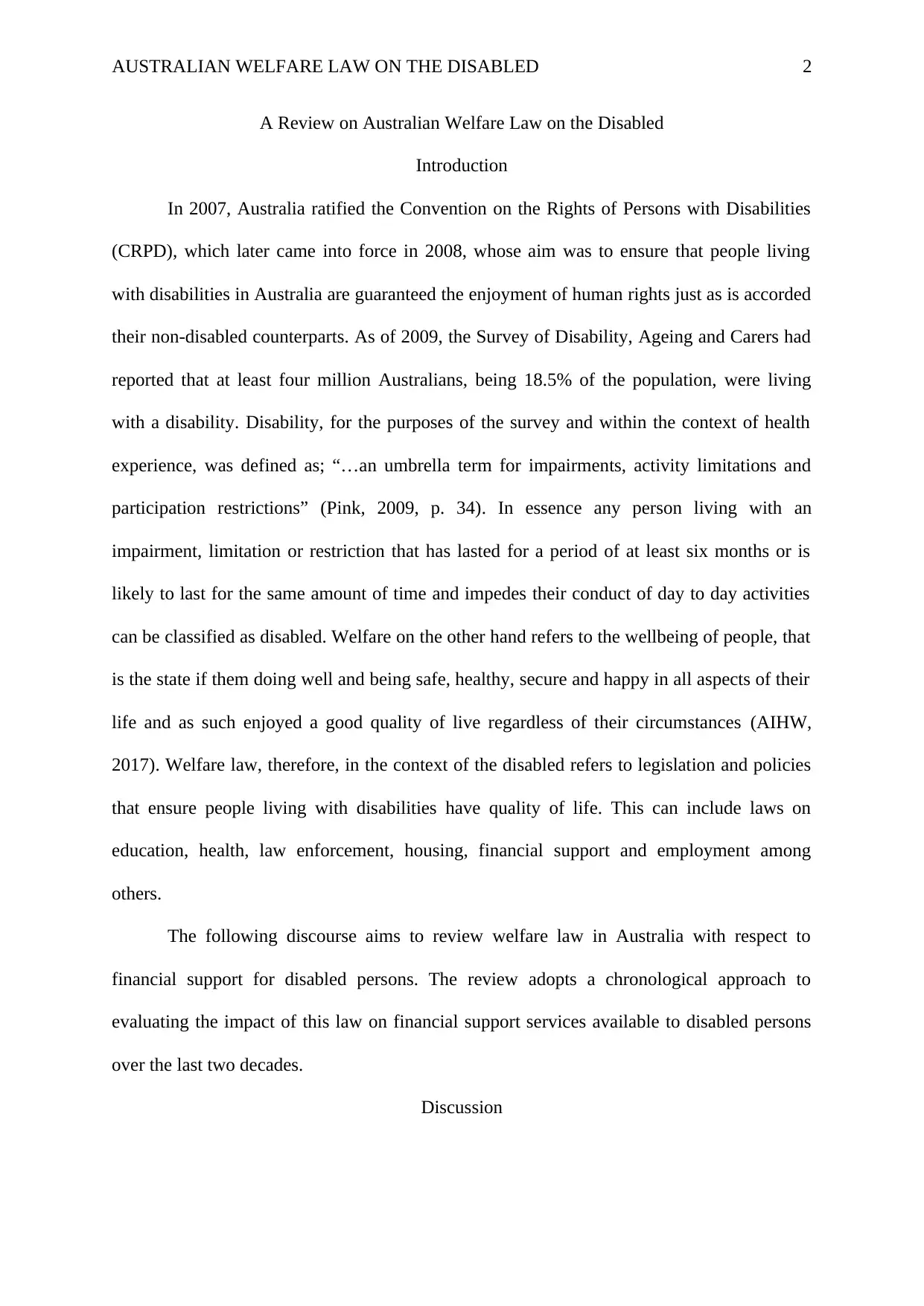
AUSTRALIAN WELFARE LAW ON THE DISABLED 2
A Review on Australian Welfare Law on the Disabled
Introduction
In 2007, Australia ratified the Convention on the Rights of Persons with Disabilities
(CRPD), which later came into force in 2008, whose aim was to ensure that people living
with disabilities in Australia are guaranteed the enjoyment of human rights just as is accorded
their non-disabled counterparts. As of 2009, the Survey of Disability, Ageing and Carers had
reported that at least four million Australians, being 18.5% of the population, were living
with a disability. Disability, for the purposes of the survey and within the context of health
experience, was defined as; “…an umbrella term for impairments, activity limitations and
participation restrictions” (Pink, 2009, p. 34). In essence any person living with an
impairment, limitation or restriction that has lasted for a period of at least six months or is
likely to last for the same amount of time and impedes their conduct of day to day activities
can be classified as disabled. Welfare on the other hand refers to the wellbeing of people, that
is the state if them doing well and being safe, healthy, secure and happy in all aspects of their
life and as such enjoyed a good quality of live regardless of their circumstances (AIHW,
2017). Welfare law, therefore, in the context of the disabled refers to legislation and policies
that ensure people living with disabilities have quality of life. This can include laws on
education, health, law enforcement, housing, financial support and employment among
others.
The following discourse aims to review welfare law in Australia with respect to
financial support for disabled persons. The review adopts a chronological approach to
evaluating the impact of this law on financial support services available to disabled persons
over the last two decades.
Discussion
A Review on Australian Welfare Law on the Disabled
Introduction
In 2007, Australia ratified the Convention on the Rights of Persons with Disabilities
(CRPD), which later came into force in 2008, whose aim was to ensure that people living
with disabilities in Australia are guaranteed the enjoyment of human rights just as is accorded
their non-disabled counterparts. As of 2009, the Survey of Disability, Ageing and Carers had
reported that at least four million Australians, being 18.5% of the population, were living
with a disability. Disability, for the purposes of the survey and within the context of health
experience, was defined as; “…an umbrella term for impairments, activity limitations and
participation restrictions” (Pink, 2009, p. 34). In essence any person living with an
impairment, limitation or restriction that has lasted for a period of at least six months or is
likely to last for the same amount of time and impedes their conduct of day to day activities
can be classified as disabled. Welfare on the other hand refers to the wellbeing of people, that
is the state if them doing well and being safe, healthy, secure and happy in all aspects of their
life and as such enjoyed a good quality of live regardless of their circumstances (AIHW,
2017). Welfare law, therefore, in the context of the disabled refers to legislation and policies
that ensure people living with disabilities have quality of life. This can include laws on
education, health, law enforcement, housing, financial support and employment among
others.
The following discourse aims to review welfare law in Australia with respect to
financial support for disabled persons. The review adopts a chronological approach to
evaluating the impact of this law on financial support services available to disabled persons
over the last two decades.
Discussion
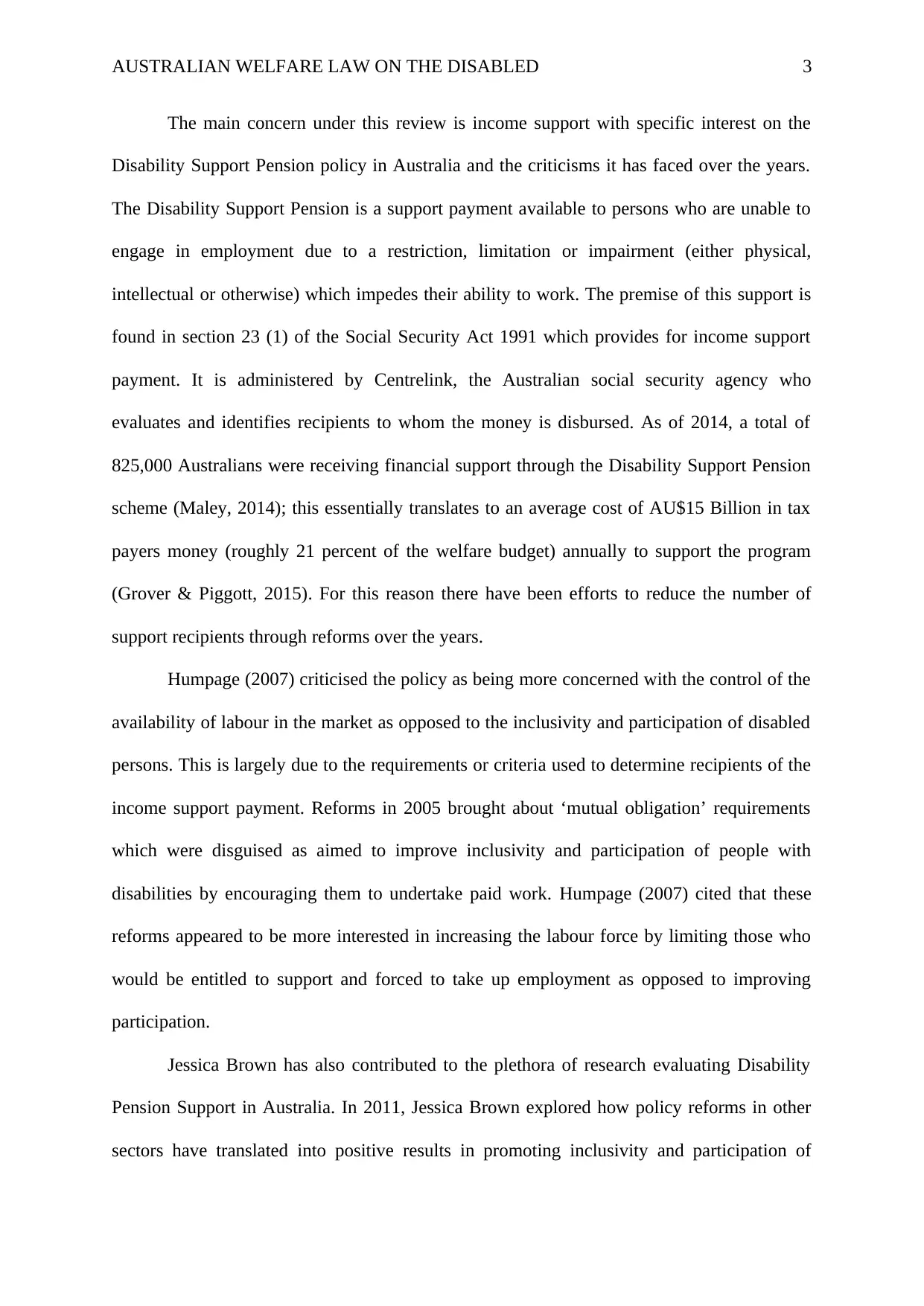
AUSTRALIAN WELFARE LAW ON THE DISABLED 3
The main concern under this review is income support with specific interest on the
Disability Support Pension policy in Australia and the criticisms it has faced over the years.
The Disability Support Pension is a support payment available to persons who are unable to
engage in employment due to a restriction, limitation or impairment (either physical,
intellectual or otherwise) which impedes their ability to work. The premise of this support is
found in section 23 (1) of the Social Security Act 1991 which provides for income support
payment. It is administered by Centrelink, the Australian social security agency who
evaluates and identifies recipients to whom the money is disbursed. As of 2014, a total of
825,000 Australians were receiving financial support through the Disability Support Pension
scheme (Maley, 2014); this essentially translates to an average cost of AU$15 Billion in tax
payers money (roughly 21 percent of the welfare budget) annually to support the program
(Grover & Piggott, 2015). For this reason there have been efforts to reduce the number of
support recipients through reforms over the years.
Humpage (2007) criticised the policy as being more concerned with the control of the
availability of labour in the market as opposed to the inclusivity and participation of disabled
persons. This is largely due to the requirements or criteria used to determine recipients of the
income support payment. Reforms in 2005 brought about ‘mutual obligation’ requirements
which were disguised as aimed to improve inclusivity and participation of people with
disabilities by encouraging them to undertake paid work. Humpage (2007) cited that these
reforms appeared to be more interested in increasing the labour force by limiting those who
would be entitled to support and forced to take up employment as opposed to improving
participation.
Jessica Brown has also contributed to the plethora of research evaluating Disability
Pension Support in Australia. In 2011, Jessica Brown explored how policy reforms in other
sectors have translated into positive results in promoting inclusivity and participation of
The main concern under this review is income support with specific interest on the
Disability Support Pension policy in Australia and the criticisms it has faced over the years.
The Disability Support Pension is a support payment available to persons who are unable to
engage in employment due to a restriction, limitation or impairment (either physical,
intellectual or otherwise) which impedes their ability to work. The premise of this support is
found in section 23 (1) of the Social Security Act 1991 which provides for income support
payment. It is administered by Centrelink, the Australian social security agency who
evaluates and identifies recipients to whom the money is disbursed. As of 2014, a total of
825,000 Australians were receiving financial support through the Disability Support Pension
scheme (Maley, 2014); this essentially translates to an average cost of AU$15 Billion in tax
payers money (roughly 21 percent of the welfare budget) annually to support the program
(Grover & Piggott, 2015). For this reason there have been efforts to reduce the number of
support recipients through reforms over the years.
Humpage (2007) criticised the policy as being more concerned with the control of the
availability of labour in the market as opposed to the inclusivity and participation of disabled
persons. This is largely due to the requirements or criteria used to determine recipients of the
income support payment. Reforms in 2005 brought about ‘mutual obligation’ requirements
which were disguised as aimed to improve inclusivity and participation of people with
disabilities by encouraging them to undertake paid work. Humpage (2007) cited that these
reforms appeared to be more interested in increasing the labour force by limiting those who
would be entitled to support and forced to take up employment as opposed to improving
participation.
Jessica Brown has also contributed to the plethora of research evaluating Disability
Pension Support in Australia. In 2011, Jessica Brown explored how policy reforms in other
sectors have translated into positive results in promoting inclusivity and participation of
⊘ This is a preview!⊘
Do you want full access?
Subscribe today to unlock all pages.

Trusted by 1+ million students worldwide
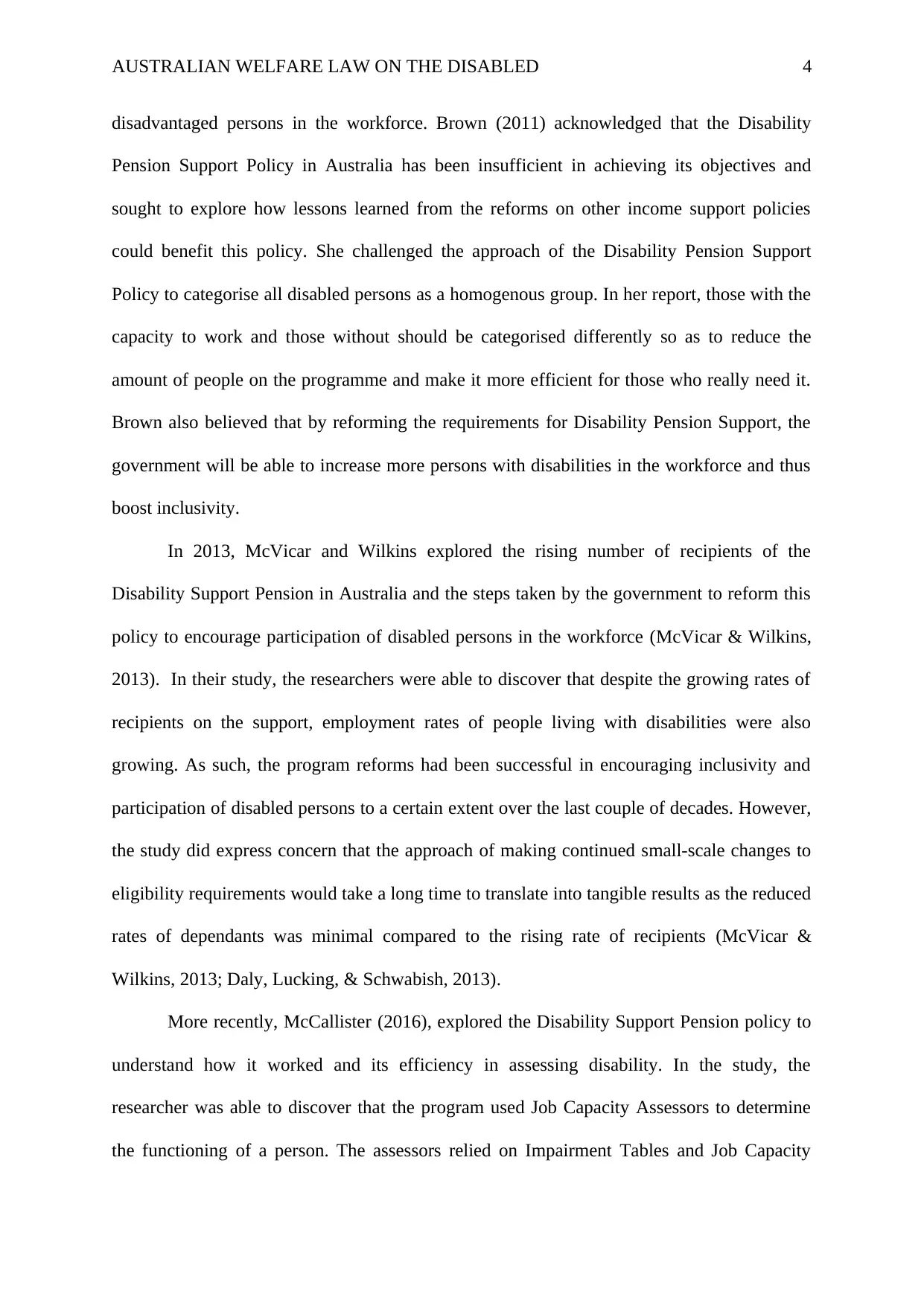
AUSTRALIAN WELFARE LAW ON THE DISABLED 4
disadvantaged persons in the workforce. Brown (2011) acknowledged that the Disability
Pension Support Policy in Australia has been insufficient in achieving its objectives and
sought to explore how lessons learned from the reforms on other income support policies
could benefit this policy. She challenged the approach of the Disability Pension Support
Policy to categorise all disabled persons as a homogenous group. In her report, those with the
capacity to work and those without should be categorised differently so as to reduce the
amount of people on the programme and make it more efficient for those who really need it.
Brown also believed that by reforming the requirements for Disability Pension Support, the
government will be able to increase more persons with disabilities in the workforce and thus
boost inclusivity.
In 2013, McVicar and Wilkins explored the rising number of recipients of the
Disability Support Pension in Australia and the steps taken by the government to reform this
policy to encourage participation of disabled persons in the workforce (McVicar & Wilkins,
2013). In their study, the researchers were able to discover that despite the growing rates of
recipients on the support, employment rates of people living with disabilities were also
growing. As such, the program reforms had been successful in encouraging inclusivity and
participation of disabled persons to a certain extent over the last couple of decades. However,
the study did express concern that the approach of making continued small-scale changes to
eligibility requirements would take a long time to translate into tangible results as the reduced
rates of dependants was minimal compared to the rising rate of recipients (McVicar &
Wilkins, 2013; Daly, Lucking, & Schwabish, 2013).
More recently, McCallister (2016), explored the Disability Support Pension policy to
understand how it worked and its efficiency in assessing disability. In the study, the
researcher was able to discover that the program used Job Capacity Assessors to determine
the functioning of a person. The assessors relied on Impairment Tables and Job Capacity
disadvantaged persons in the workforce. Brown (2011) acknowledged that the Disability
Pension Support Policy in Australia has been insufficient in achieving its objectives and
sought to explore how lessons learned from the reforms on other income support policies
could benefit this policy. She challenged the approach of the Disability Pension Support
Policy to categorise all disabled persons as a homogenous group. In her report, those with the
capacity to work and those without should be categorised differently so as to reduce the
amount of people on the programme and make it more efficient for those who really need it.
Brown also believed that by reforming the requirements for Disability Pension Support, the
government will be able to increase more persons with disabilities in the workforce and thus
boost inclusivity.
In 2013, McVicar and Wilkins explored the rising number of recipients of the
Disability Support Pension in Australia and the steps taken by the government to reform this
policy to encourage participation of disabled persons in the workforce (McVicar & Wilkins,
2013). In their study, the researchers were able to discover that despite the growing rates of
recipients on the support, employment rates of people living with disabilities were also
growing. As such, the program reforms had been successful in encouraging inclusivity and
participation of disabled persons to a certain extent over the last couple of decades. However,
the study did express concern that the approach of making continued small-scale changes to
eligibility requirements would take a long time to translate into tangible results as the reduced
rates of dependants was minimal compared to the rising rate of recipients (McVicar &
Wilkins, 2013; Daly, Lucking, & Schwabish, 2013).
More recently, McCallister (2016), explored the Disability Support Pension policy to
understand how it worked and its efficiency in assessing disability. In the study, the
researcher was able to discover that the program used Job Capacity Assessors to determine
the functioning of a person. The assessors relied on Impairment Tables and Job Capacity
Paraphrase This Document
Need a fresh take? Get an instant paraphrase of this document with our AI Paraphraser
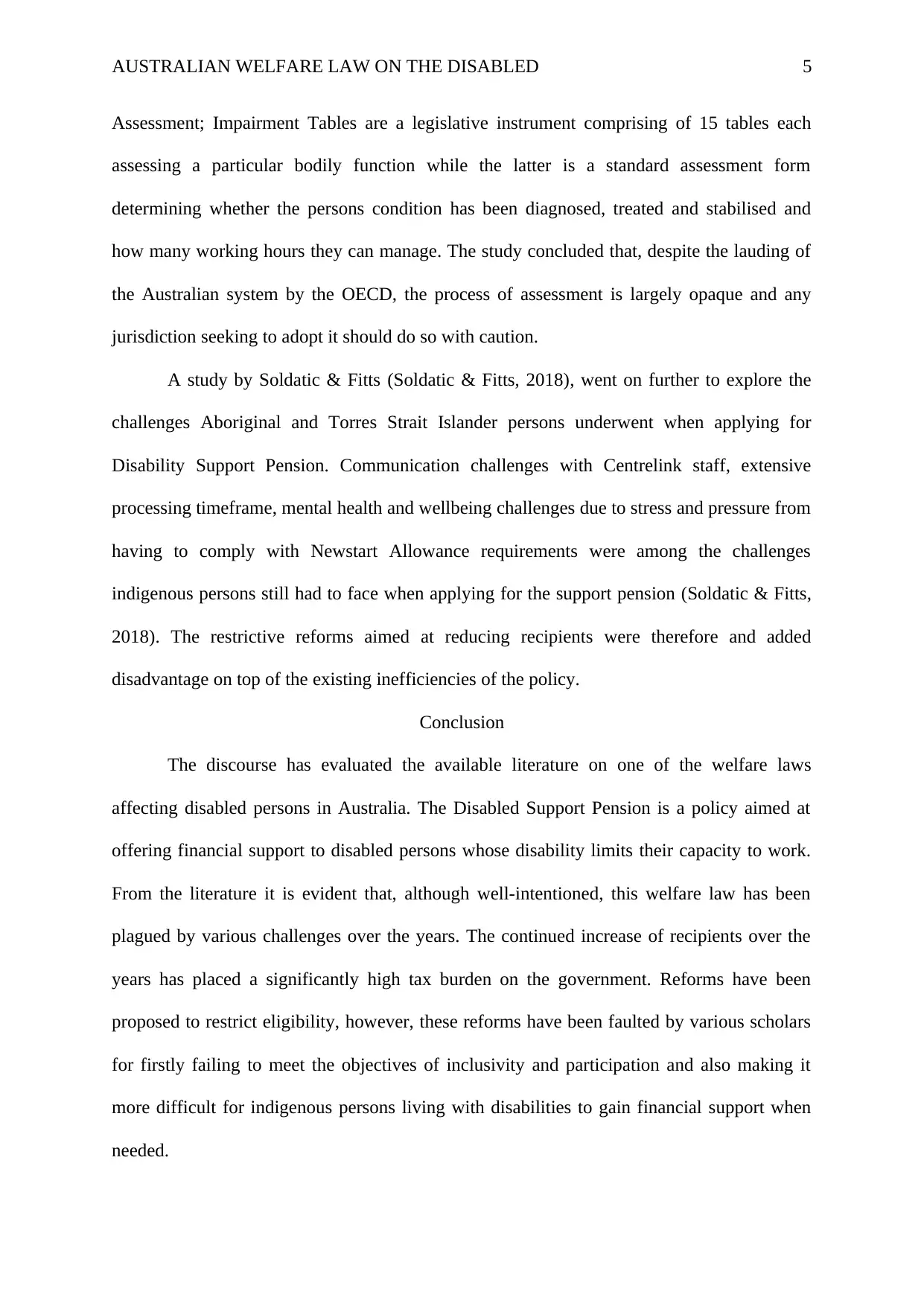
AUSTRALIAN WELFARE LAW ON THE DISABLED 5
Assessment; Impairment Tables are a legislative instrument comprising of 15 tables each
assessing a particular bodily function while the latter is a standard assessment form
determining whether the persons condition has been diagnosed, treated and stabilised and
how many working hours they can manage. The study concluded that, despite the lauding of
the Australian system by the OECD, the process of assessment is largely opaque and any
jurisdiction seeking to adopt it should do so with caution.
A study by Soldatic & Fitts (Soldatic & Fitts, 2018), went on further to explore the
challenges Aboriginal and Torres Strait Islander persons underwent when applying for
Disability Support Pension. Communication challenges with Centrelink staff, extensive
processing timeframe, mental health and wellbeing challenges due to stress and pressure from
having to comply with Newstart Allowance requirements were among the challenges
indigenous persons still had to face when applying for the support pension (Soldatic & Fitts,
2018). The restrictive reforms aimed at reducing recipients were therefore and added
disadvantage on top of the existing inefficiencies of the policy.
Conclusion
The discourse has evaluated the available literature on one of the welfare laws
affecting disabled persons in Australia. The Disabled Support Pension is a policy aimed at
offering financial support to disabled persons whose disability limits their capacity to work.
From the literature it is evident that, although well-intentioned, this welfare law has been
plagued by various challenges over the years. The continued increase of recipients over the
years has placed a significantly high tax burden on the government. Reforms have been
proposed to restrict eligibility, however, these reforms have been faulted by various scholars
for firstly failing to meet the objectives of inclusivity and participation and also making it
more difficult for indigenous persons living with disabilities to gain financial support when
needed.
Assessment; Impairment Tables are a legislative instrument comprising of 15 tables each
assessing a particular bodily function while the latter is a standard assessment form
determining whether the persons condition has been diagnosed, treated and stabilised and
how many working hours they can manage. The study concluded that, despite the lauding of
the Australian system by the OECD, the process of assessment is largely opaque and any
jurisdiction seeking to adopt it should do so with caution.
A study by Soldatic & Fitts (Soldatic & Fitts, 2018), went on further to explore the
challenges Aboriginal and Torres Strait Islander persons underwent when applying for
Disability Support Pension. Communication challenges with Centrelink staff, extensive
processing timeframe, mental health and wellbeing challenges due to stress and pressure from
having to comply with Newstart Allowance requirements were among the challenges
indigenous persons still had to face when applying for the support pension (Soldatic & Fitts,
2018). The restrictive reforms aimed at reducing recipients were therefore and added
disadvantage on top of the existing inefficiencies of the policy.
Conclusion
The discourse has evaluated the available literature on one of the welfare laws
affecting disabled persons in Australia. The Disabled Support Pension is a policy aimed at
offering financial support to disabled persons whose disability limits their capacity to work.
From the literature it is evident that, although well-intentioned, this welfare law has been
plagued by various challenges over the years. The continued increase of recipients over the
years has placed a significantly high tax burden on the government. Reforms have been
proposed to restrict eligibility, however, these reforms have been faulted by various scholars
for firstly failing to meet the objectives of inclusivity and participation and also making it
more difficult for indigenous persons living with disabilities to gain financial support when
needed.
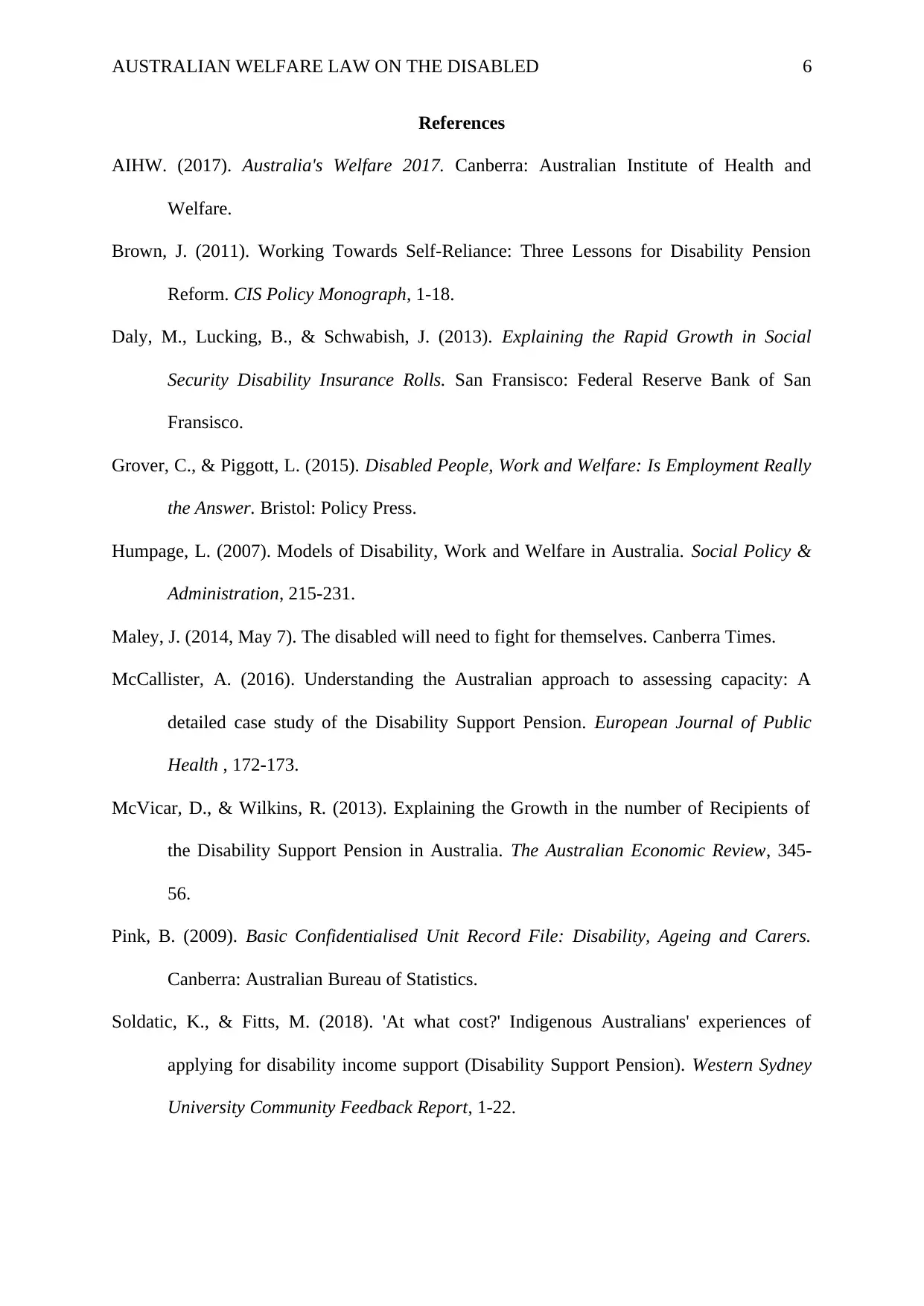
AUSTRALIAN WELFARE LAW ON THE DISABLED 6
References
AIHW. (2017). Australia's Welfare 2017. Canberra: Australian Institute of Health and
Welfare.
Brown, J. (2011). Working Towards Self-Reliance: Three Lessons for Disability Pension
Reform. CIS Policy Monograph, 1-18.
Daly, M., Lucking, B., & Schwabish, J. (2013). Explaining the Rapid Growth in Social
Security Disability Insurance Rolls. San Fransisco: Federal Reserve Bank of San
Fransisco.
Grover, C., & Piggott, L. (2015). Disabled People, Work and Welfare: Is Employment Really
the Answer. Bristol: Policy Press.
Humpage, L. (2007). Models of Disability, Work and Welfare in Australia. Social Policy &
Administration, 215-231.
Maley, J. (2014, May 7). The disabled will need to fight for themselves. Canberra Times.
McCallister, A. (2016). Understanding the Australian approach to assessing capacity: A
detailed case study of the Disability Support Pension. European Journal of Public
Health , 172-173.
McVicar, D., & Wilkins, R. (2013). Explaining the Growth in the number of Recipients of
the Disability Support Pension in Australia. The Australian Economic Review, 345-
56.
Pink, B. (2009). Basic Confidentialised Unit Record File: Disability, Ageing and Carers.
Canberra: Australian Bureau of Statistics.
Soldatic, K., & Fitts, M. (2018). 'At what cost?' Indigenous Australians' experiences of
applying for disability income support (Disability Support Pension). Western Sydney
University Community Feedback Report, 1-22.
References
AIHW. (2017). Australia's Welfare 2017. Canberra: Australian Institute of Health and
Welfare.
Brown, J. (2011). Working Towards Self-Reliance: Three Lessons for Disability Pension
Reform. CIS Policy Monograph, 1-18.
Daly, M., Lucking, B., & Schwabish, J. (2013). Explaining the Rapid Growth in Social
Security Disability Insurance Rolls. San Fransisco: Federal Reserve Bank of San
Fransisco.
Grover, C., & Piggott, L. (2015). Disabled People, Work and Welfare: Is Employment Really
the Answer. Bristol: Policy Press.
Humpage, L. (2007). Models of Disability, Work and Welfare in Australia. Social Policy &
Administration, 215-231.
Maley, J. (2014, May 7). The disabled will need to fight for themselves. Canberra Times.
McCallister, A. (2016). Understanding the Australian approach to assessing capacity: A
detailed case study of the Disability Support Pension. European Journal of Public
Health , 172-173.
McVicar, D., & Wilkins, R. (2013). Explaining the Growth in the number of Recipients of
the Disability Support Pension in Australia. The Australian Economic Review, 345-
56.
Pink, B. (2009). Basic Confidentialised Unit Record File: Disability, Ageing and Carers.
Canberra: Australian Bureau of Statistics.
Soldatic, K., & Fitts, M. (2018). 'At what cost?' Indigenous Australians' experiences of
applying for disability income support (Disability Support Pension). Western Sydney
University Community Feedback Report, 1-22.
⊘ This is a preview!⊘
Do you want full access?
Subscribe today to unlock all pages.

Trusted by 1+ million students worldwide

AUSTRALIAN WELFARE LAW ON THE DISABLED 7
1 out of 7
Related Documents
Your All-in-One AI-Powered Toolkit for Academic Success.
+13062052269
info@desklib.com
Available 24*7 on WhatsApp / Email
![[object Object]](/_next/static/media/star-bottom.7253800d.svg)
Unlock your academic potential
Copyright © 2020–2025 A2Z Services. All Rights Reserved. Developed and managed by ZUCOL.





